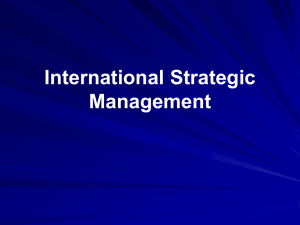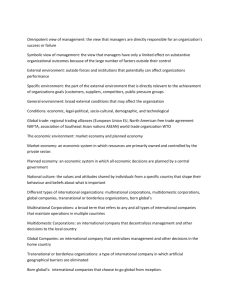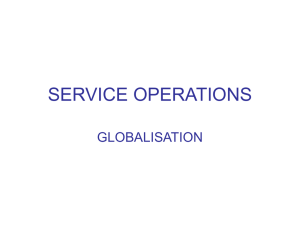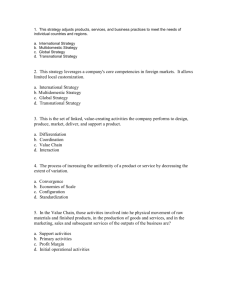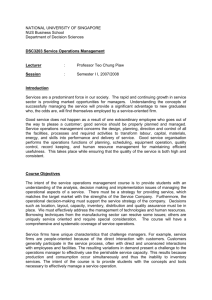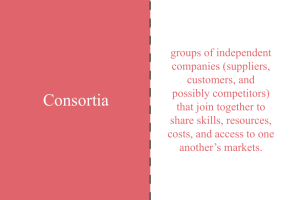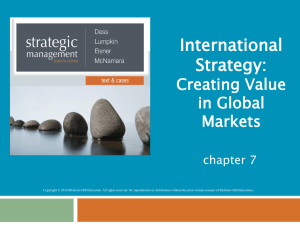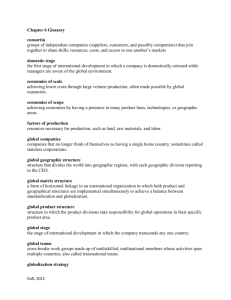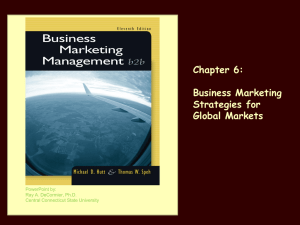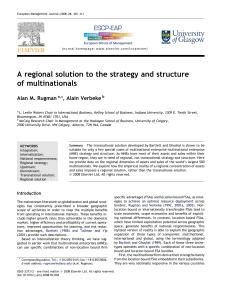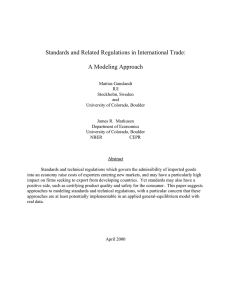Quiz 8 | Chapter 7 In Japan, land and therefore warehousing is
advertisement
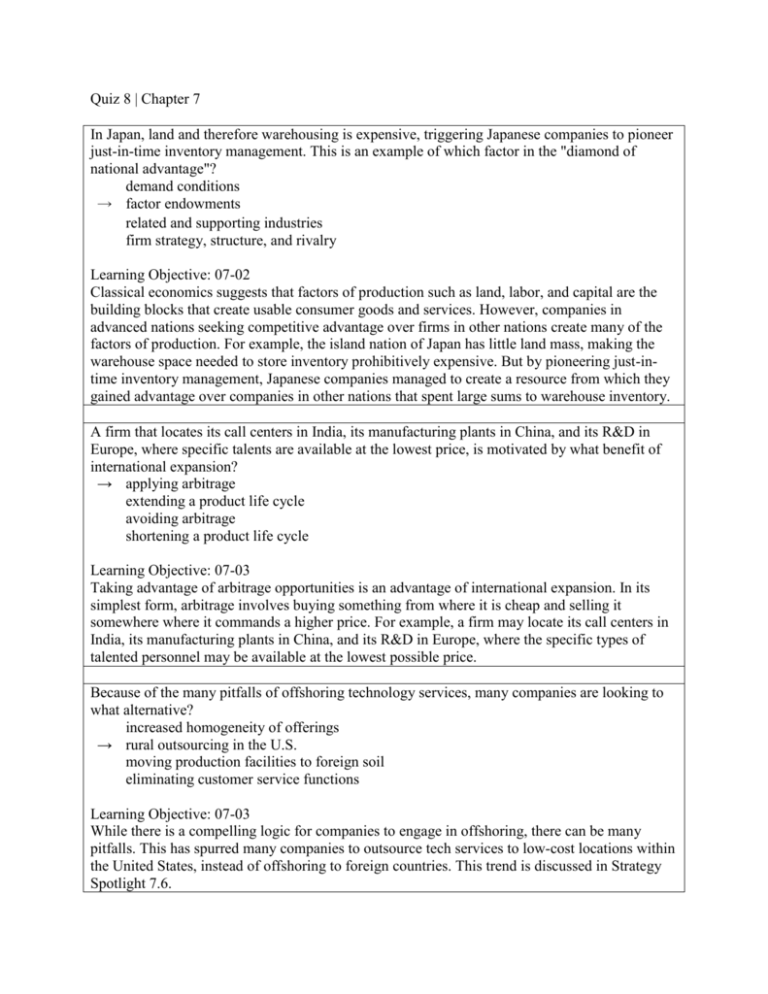
Quiz 8 | Chapter 7 In Japan, land and therefore warehousing is expensive, triggering Japanese companies to pioneer just-in-time inventory management. This is an example of which factor in the "diamond of national advantage"? demand conditions → factor endowments related and supporting industries firm strategy, structure, and rivalry Learning Objective: 07-02 Classical economics suggests that factors of production such as land, labor, and capital are the building blocks that create usable consumer goods and services. However, companies in advanced nations seeking competitive advantage over firms in other nations create many of the factors of production. For example, the island nation of Japan has little land mass, making the warehouse space needed to store inventory prohibitively expensive. But by pioneering just-intime inventory management, Japanese companies managed to create a resource from which they gained advantage over companies in other nations that spent large sums to warehouse inventory. A firm that locates its call centers in India, its manufacturing plants in China, and its R&D in Europe, where specific talents are available at the lowest price, is motivated by what benefit of international expansion? → applying arbitrage extending a product life cycle avoiding arbitrage shortening a product life cycle Learning Objective: 07-03 Taking advantage of arbitrage opportunities is an advantage of international expansion. In its simplest form, arbitrage involves buying something from where it is cheap and selling it somewhere where it commands a higher price. For example, a firm may locate its call centers in India, its manufacturing plants in China, and its R&D in Europe, where the specific types of talented personnel may be available at the lowest possible price. Because of the many pitfalls of offshoring technology services, many companies are looking to what alternative? increased homogeneity of offerings → rural outsourcing in the U.S. moving production facilities to foreign soil eliminating customer service functions Learning Objective: 07-03 While there is a compelling logic for companies to engage in offshoring, there can be many pitfalls. This has spurred many companies to outsource tech services to low-cost locations within the United States, instead of offshoring to foreign countries. This trend is discussed in Strategy Spotlight 7.6. Which of the following would be viewed as a strength of global strategies? the potential to increase costs of operation even if the primary market is at home. a firm being solely dependent on the domestic market. a firm with large margins at home helping subsidize its operations in other nations. → helps create uniform standards of quality throughout the world. Learning Objective: 07-05 An advantage of a global strategy is that it can enable a firm to create a standard level of quality throughout the world. Multidomestic strategy tends to have all of the following associated limitations EXCEPT: decreased ability to realize cost savings through scale economies. greater difficulty in transferring knowledge across countries. may lead to "overadaptation" as conditions change. → inability to take advantage of innovations in local markets. Learning Objective: 07-05 (Refer To: Exhibit 7.7) According to Exhibit 7.7, the multidomestic strategy have the following limitations: decreased ability to realize cost savings through scale economies, greater difficulty in transferring knowledge across countries, and it may lead to "overadaptation" as conditions change. High pressure for local adaptation as well as high pressure to lower costs will most likely lead to which of the following strategies? Refer To: Exhibit 7.4 → transnational global international multidomestic Learning Objective: 07-05 The transnational strategy is based on firms' optimizing the trade-offs associated with efficiency, local adaptation, and learning, and is used in industries where the pressures for both local adaptation and lowering costs are high. According to a study by Rugman and Verbeke, most of the world's largest firms today: conduct business in a single country. → would best be considered regional or biregional in terms of sales. are truly global in nature. are increasingly against global trade. Learning Objective: 07-06 Extensive analysis of the distribution data of sales across different countries and regions led Alan Rugman and Alain Verbeke to conclude that there is a stronger case to be made in favor of regionalization than globalization. With a criterion of 20 percent of sales each in at least two of the three economic regions, only 25 of the 500 largest firms could be considered global. Thus most companies are regional or at best, bioregional, not global, even today. A risk of using ________ for international expansion is that a firm's collaborator will become familiar with trade secrets, make modifications to the product, and sell it independently, especially in countries with weak laws protecting intellectual property. exporting wholly owned subsidiary → licensing strategic alliance Learning Objective: 07-07 With licensing, the licensee may eventually become so familiar with the patent and trade secrets that it may become a competitor; that is, the licensee may make some modifications to the product and manufacture and sell it independently of the licensor without having to pay a royalty fee. This potential situation is aggravated in countries that have relatively weak laws to protect intellectual property. The risks associated with using a wholly owned subsidiary for expansion can be lessened by: choosing the firm's partner carefully. implementing special policies to protect patents and trademarks. minimizing one's investment until products are embraced by the foreign market. → hiring local talent. Learning Objective: 07-07 With franchising, joint ventures, or strategic alliances, the risk is shared with the firm's partners. With wholly owned subsidiaries, the entire risk is assumed by the parent company. The risks associated with doing business in a new country (e.g., political, cultural, and legal) can be lessened by hiring local talent. What strategy does Heineken follow in the global beer market? Overall cost leadership → Differentiation Focus strategy Transnational → Multidomestic
